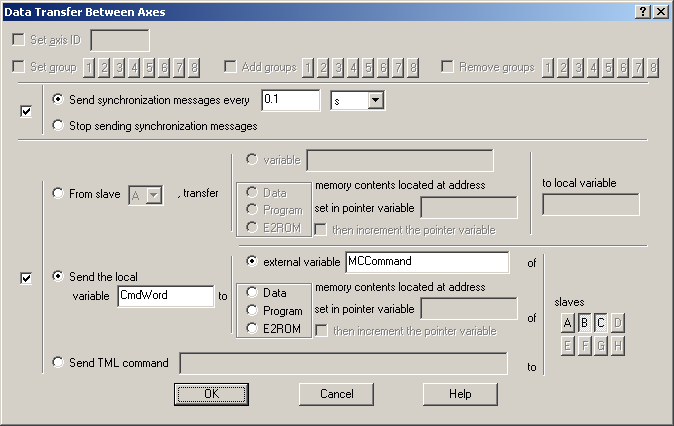The “Data Transfer Between Axes” dialogue allows you to program data transfer operations between motion controller and the slaves. From this dialogue, you can also activate/deactivate the synchronization between axes.

Check Synchronization group to activate/deactivate the synchronization procedure. This procedure requires activating one axis as a synchronization master. The other axes are deactivated and are synchronization slaves. Select Send synchronization messages every… and set the time interval between synchronization messages, to activate the synchronization master. Recommended starting value for the time interval is 20ms. When synchronization procedure is active, the execution of the control loops on the slaves is synchronized with those of the master within a 10µs time interval. Due to this powerful feature, drifts between master and slave axes are eliminated. Deactivate the synchronization procedure by choosing Stop sending synchronization messages. This will disable the synchronization master and set the axis as a synchronization slave. In the absence of a master, the synchronization process is stopped.
The data transfer operations may be split into three categories:
| 1. | Read data from a remote axis. A variable or a memory location from the remote axis is saved into a local variable |
| 2. | Write data to a remote axis or group of axes. A variable or a memory location of a remote axis or group of axes is written with the value of a local variable |
| 3. | Send TML commands from local drive to a remote drive or group of drives |
Check data transfer commands, and select From slave to read from the slave axis specified, the value of a variable or the data / program / E2ROM memory contents located at an address set in a pointer variable. The data is saved in the local TML variable indicated in to local variable field. The local variable can be either a 16-bit or a 32-bit TML data. Its type, dictates the data transfer size. Check then increment the pointer variable to automatically increment the pointer by one or two function of the local variable type, after the transfer is performed. The memory type is split into 3 categories: data – for the RAM area with TML data, program – for the RAM area with TML programs and E2ROM – for the EEPROM area with TML programs.
Select Send the local variable to copy on a slave axis or several slave axes, the value of the local variable specified. The data is saved either in an external/remote variable or in the data / program / E2ROM memory location(s) from address set in the pointer variable indicated. The local variable can be either a 16-bit or a 32-bit TML data. Its type, dictates the data transfer size. Check then increment the pointer variable to automatically increment the pointer by one or two function of the local variable type, after the transfer is performed. The memory type is split into 3 categories: data – for the RAM area with TML data, program – for the RAM area with TML programs and E2ROM – for the EEPROM area with TML programs. Push the buttons to select the destination of the data transfer operation.
Select Send TML command to program the motion controller to transmit the TML command(s) you type in the associated field towards the selected slaves. destination specified at the axis/group field. The transmission is done when the command is executed.
Remarks:
| • | This command offers a very powerful tool through which the motion controller may control the slaves from the network. For example it can start or stop the other drives motion or check their status |
| • | You may type multiple TML commands separated by semicolon (;). These will be sent one by one in the order of occurrence in the edit. |
| • | Via this type of messages, you can send all the TML instructions having an instruction code of maximum 4 words. In this category enter most of the TML commands (see TML Instruction Coding and the detailed description of the TML Instructions). |
OK: Close this dialogue and save the operations selected in your motion sequence list.
Cancel: Close this dialogue without saving anything in your motion sequence list.
Help: Open this help page.
See also:
Data Transfer Between Axes – TML Programming Details